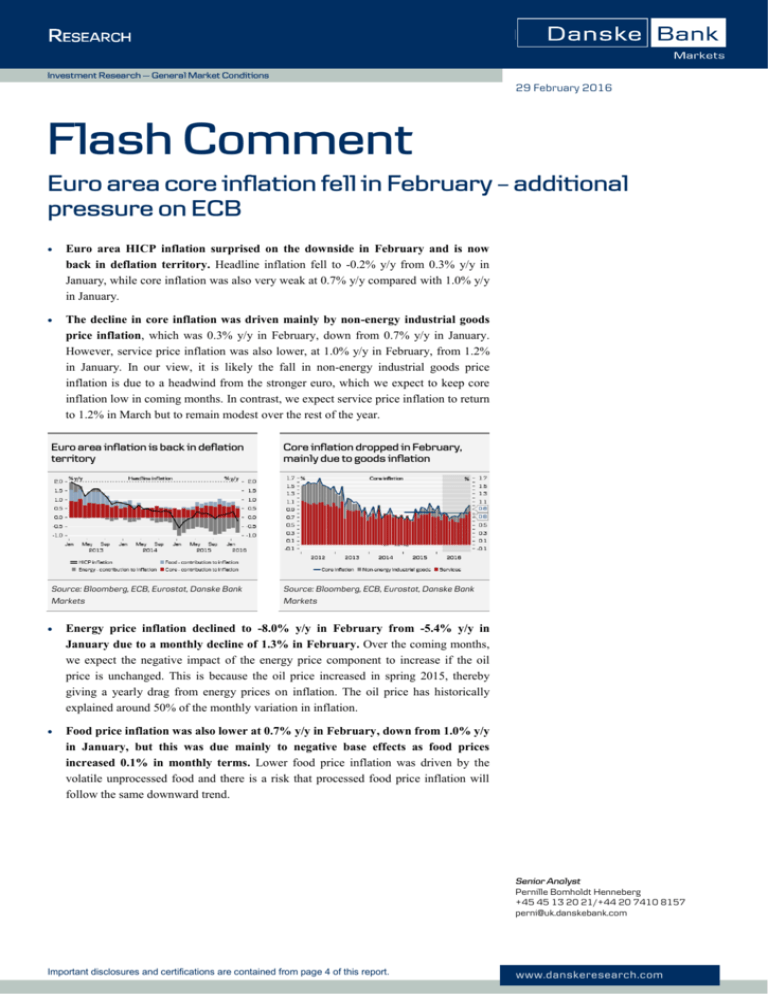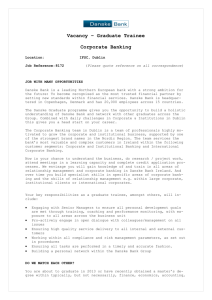Flash Comment: Euro area core inflation fell in February – additional
advertisement

Investment Research — General Market Conditions 29 February 2016 Flash Comment Euro area core inflation fell in February – additional pressure on ECB Euro area HICP inflation surprised on the downside in February and is now back in deflation territory. Headline inflation fell to -0.2% y/y from 0.3% y/y in January, while core inflation was also very weak at 0.7% y/y compared with 1.0% y/y in January. The decline in core inflation was driven mainly by non-energy industrial goods price inflation, which was 0.3% y/y in February, down from 0.7% y/y in January. However, service price inflation was also lower, at 1.0% y/y in February, from 1.2% in January. In our view, it is likely the fall in non-energy industrial goods price inflation is due to a headwind from the stronger euro, which we expect to keep core inflation low in coming months. In contrast, we expect service price inflation to return to 1.2% in March but to remain modest over the rest of the year. Euro area inflation is back in deflation territory Core inflation dropped in February, mainly due to goods inflation Source: Bloomberg, ECB, Eurostat, Danske Bank Markets Source: Bloomberg, ECB, Eurostat, Danske Bank Markets Energy price inflation declined to -8.0% y/y in February from -5.4% y/y in January due to a monthly decline of 1.3% in February. Over the coming months, we expect the negative impact of the energy price component to increase if the oil price is unchanged. This is because the oil price increased in spring 2015, thereby giving a yearly drag from energy prices on inflation. The oil price has historically explained around 50% of the monthly variation in inflation. Food price inflation was also lower at 0.7% y/y in February, down from 1.0% y/y in January, but this was due mainly to negative base effects as food prices increased 0.1% in monthly terms. Lower food price inflation was driven by the volatile unprocessed food and there is a risk that processed food price inflation will follow the same downward trend. Senior Analyst Pernille Bomholdt Henneberg +45 45 13 20 21/+44 20 7410 8157 perni@uk.danskebank.com Important disclosures and certifications are contained from page 4 of this report. www.danskeresearch.com Flash Comment The drag from energy price inflation slowly starts to fade in May Inflation in unprocessed food declined in February Source: Bloomberg, ECB, Eurostat, Danske Bank Markets Source: Bloomberg, ECB, Eurostat, Danske Bank Markets Looking ahead, we forecast negative inflation prints for the next five months. The inflation market is still priced more negatively, with negative prints priced until November this year. From May this year, the large negative drag from the low oil price should slowly start to fade and we still look for an increase in headline inflation to above 1.0% in January 2017. We expect negative inflation prints over the next five months The market is pricing deflation until December this year Source: Bloomberg, ECB, Eurostat, Danske Bank Markets Source: Bloomberg, ECB, Eurostat, Danske Bank Markets The fall in core inflation in particular is a big concern for the ECB and it is under considerable pressure ahead of the next meeting on 10 March. Added to the very low spot inflation, the ECB’s preferred measure for inflation expectations (5Y5Y inflation swap) has been on a downward trend since the disappointment at the ECB meeting in December and is now below 1.4%. Mario Draghi expressed concern about the measure when it declined below 2% in 2014 but despite pricing of additional easing from the ECB, the market-based inflation expectations remain very low. At the ECB meeting in March, we believe the communication from Draghi will be very important. We expect the ECB to cut the deposit rate by 10bp and introduce a two-tier deposit rate system. The ECB is also set to maintain its forward guidance on policy rates and signals it can go lower. Related to this, the ECB could consider strengthening its forward guidance additionally. In terms of QE, we expect the ECB to frontload its purchases by EUR20bn per month this spring, supporting the very weak actual and expected inflation. As the programme remains open ended, this could also be seen as a stronger signal from the ECB to fight low inflation. 2| 29 February 2016 www.danskeresearch.com Flash Comment ECB set to lower its inflation forecast significantly in March In particular, the ECB's core inflation forecast is too optimistic Source: Bloomberg, ECB, Eurostat, Danske Bank Markets Source: Bloomberg, ECB, Eurostat, Danske Bank Markets 3| 29 February 2016 www.danskeresearch.com Flash Comment Disclosures This research report has been prepared by Danske Bank Markets, a division of Danske Bank A/S (‘Danske Bank’). The author of the research report is Pernille Bomholdt Henneberg, Senior Analyst. Analyst certification Each research analyst responsible for the content of this research report certifies that the views expressed in the research report accurately reflect the research analyst’s personal view about the financial instruments and issuers covered by the research report. Each responsible research analyst further certifies that no part of the compensation of the research analyst was, is or will be, directly or indirectly, related to the specific recommendations expressed in the research report. Regulation Danske Bank is authorised and subject to regulation by the Danish Financial Supervisory Authority and is subject to the rules and regulation of the relevant regulators in all other jurisdictions where it conducts business. Danske Bank is subject to limited regulation by the Financial Conduct Authority and the Prudential Regulation Authority (UK). Details on the extent of the regulation by the Financial Conduct Authority and the Prudential Regulation Authority are available from Danske Bank on request. The research reports of Danske Bank are prepared in accordance with the Danish Society of Financial Analysts’ rules of ethics and the recommendations of the Danish Securities Dealers Association. Conflicts of interest Danske Bank has established procedures to prevent conflicts of interest and to ensure the provision of highquality research based on research objectivity and independence. These procedures are documented in Danske Bank’s research policies. Employees within Danske Bank’s Research Departments have been instructed that any request that might impair the objectivity and independence of research shall be referred to Research Management and the Compliance Department. Danske Bank’s Research Departments are organised independently from and do not report to other business areas within Danske Bank. Research analysts are remunerated in part based on the overall profitability of Danske Bank, which includes investment banking revenues, but do not receive bonuses or other remuneration linked to specific corporate finance or debt capital transactions. Financial models and/or methodology used in this research report Calculations and presentations in this research report are based on standard econometric tools and methodology as well as publicly available statistics for each individual security, issuer and/or country. Documentation can be obtained from the authors on request. Risk warning Major risks connected with recommendations or opinions in this research report, including a sensitivity analysis of relevant assumptions, are stated throughout the text. Date of first publication See the front page of this research report for the date of first publication. General disclaimer This research has been prepared by Danske Bank Markets (a division of Danske Bank A/S). It is provided for informational purposes only. It does not constitute or form part of, and shall under no circumstances be considered as, an offer to sell or a solicitation of an offer to purchase or sell any relevant financial instruments (i.e. financial instruments mentioned herein or other financial instruments of any issuer mentioned herein and/or options, warrants, rights or other interests with respect to any such financial instruments) (‘Relevant Financial Instruments’). The research report has been prepared independently and solely on the basis of publicly available information that Danske Bank considers to be reliable. While reasonable care has been taken to ensure that its contents are not untrue or misleading, no representation is made as to its accuracy or completeness and Danske Bank, its affiliates and subsidiaries accept no liability whatsoever for any direct or consequential loss, including without limitation any loss of profits, arising from reliance on this research report. The opinions expressed herein are the opinions of the research analysts responsible for the research report and reflect their judgement as of the date hereof. These opinions are subject to change, and Danske Bank does not undertake to notify any recipient of this research report of any such change nor of any other changes related to the information provided in this research report. 4| 29 February 2016 www.danskeresearch.com Flash Comment This research report is not intended for, and may not be redistributed to, retail customers in the United Kingdom or the United States. This research report is protected by copyright and is intended solely for the designated addressee. It may not be reproduced or distributed, in whole or in part, by any recipient for any purpose without Danske Bank’s prior written consent. Disclaimer related to distribution in the United States This research report was created by Danske Bank A/S and is distributed in the United States by Danske Markets Inc., a U.S. registered broker-dealer and subsidiary of Danske Bank A/S, pursuant to SEC Rule 15a-6 and related interpretations issued by the U.S. Securities and Exchange Commission. The research report is intended for distribution in the United States solely to ‘U.S. institutional investors’ as defined in SEC Rule 15a-6. Danske Markets Inc. accepts responsibility for this research report in connection with distribution in the United States solely to ‘U.S. institutional investors’. Danske Bank is not subject to U.S. rules with regard to the preparation of research reports and the independence of research analysts. In addition, the research analysts of Danske Bank who have prepared this research report are not registered or qualified as research analysts with the NYSE or FINRA but satisfy the applicable requirements of a non-U.S. jurisdiction. Any U.S. investor recipient of this research report who wishes to purchase or sell any Relevant Financial Instrument may do so only by contacting Danske Markets Inc. directly and should be aware that investing in nonU.S. financial instruments may entail certain risks. Financial instruments of non-U.S. issuers may not be registered with the U.S. Securities and Exchange Commission and may not be subject to the reporting and auditing standards of the U.S. Securities and Exchange Commission. 5| 29 February 2016 www.danskeresearch.com






